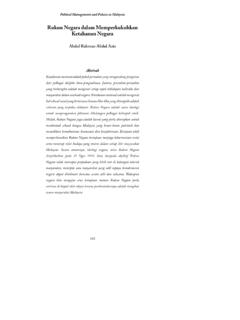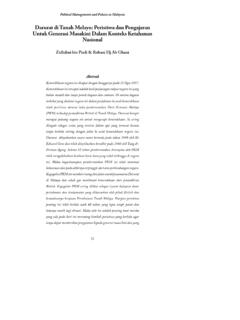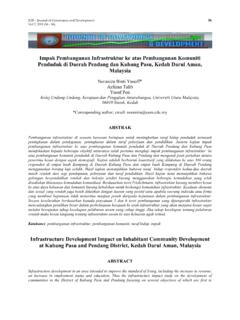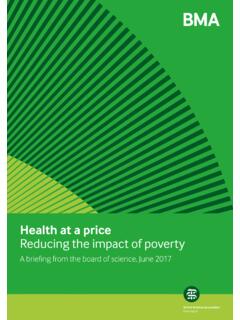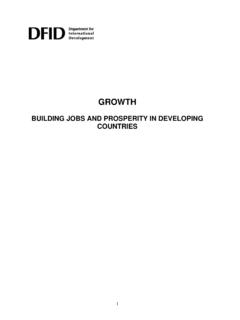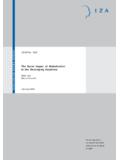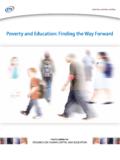Transcription of “Impact on poverty and income inequality in Malaysia’s ...
1 impact on poverty and income inequality in Malaysia seconomic growth AUTHORSR abiul Islam, Ahmad Bashawir Abdul Ghani, Irwanshah ZainalAbidin, Jeya Malar RayaiappanARTICLE INFOR abiul Islam, Ahmad Bashawir Abdul Ghani, Irwanshah ZainalAbidin and Jeya Malar Rayaiappan (2017). impact on povertyand income inequality in Malaysia s economic and Perspectives in Management , 15(1), (1). (1). ONTuesday, 28 March 2017 LICENSE This work is licensed under a Creative Commons Attribution-NonCommercial International LicenseJOURNAL"Problems and Perspectives in Management "ISSN PRINT1727-7051 ISSN ONLINE1810-5467 PUBLISHERLLC Consulting Publishing Company BusinessPerspectives NUMBER OF REFERENCES20 NUMBER OF FIGURES0 NUMBER OF TABLES10 The author(s) 2017.
2 This publication is an open access and Perspectives in Management, Volume 15, Issue 1, 2017 55 Rabiul Islam (Malaysia), Ahmad Bashawir Abdul Ghani (Malaysia), Irwanshah Zainal Abidin (Malaysia), Jeya Malar Rayaiappan (Malaysia) impact on poverty and income inequality in Malaysia s economic growth Abstract poverty and income inequality are extreme issues that still exist in Malaysia. Any rise in poverty and income inequality defi-nitely affect economic growth. There are many great efforts taken by the government of Malaysia to eradicate poverty and to reduce the gap of income inequality which occurs since 1970 s.
3 The incidence of poverty and income inequality is higher in rural areas compared to urban areas. This paper is mainly to study the level of poverty and income inequality in Malaysia together with government intervention to develop Malaysia s economic growth. The research is focused among the working people at Ipoh, Perak. In this paper, questionnaire forms are being distributed to get information regarding the issue of pov-erty and income inequality . It also looks into the strategies taken by the government of Malaysia to eradicate poverty and income inequality .
4 Few recommendations are given in terms of education policy, financial aid and assistance from govern-ment and non-government organization (NGO) to upgrade the standard and quality of living among the poor and lower- income group of people. Keywords: poverty , income , inequality , economic growth. JEL Classification: O1, O4. Introduc tion Malaysia is an Asian country with unique multiracial peoples of different religions, cultures and languages. The three largest ethnics in Malaysia are Malay, Chi-nese and Indian.
5 In Sabah and Sarawak, there are in-digenous ethnic groups with their own unique culture and Federation of Malaysia comprises 13 states in Peninsular Malaysia, and Sabah, Sarawak in east Malaysia. There are also 3 federal territories namely Kuala Lumpur, Putrajaya and the aspect of economy, Malaysia is a developing country with a highly open upper-middle income . Formerly, Malaysia focuses on the primary sector which is from the natural resources in agriculture and forestry. Later, Malaysia moves on to the secondary sector which is manufacturing and industry.
6 This sector provides a greater contribution and act as the backbone of its economy. At this era, Malaysia emphasises on tertiary sector which is the service sector. People living in urban areas can have a good access to their daily basic needs and facilities. The cities devel-opment will definitely increase the demand of the peo-ple and eventually this will bring to higher living cost. In contrast, people living in rural area such as in Ke-lantan, Sabah and Sarawak are poor and have low in- Rabiul Islam, Ahmad Bashawir Abdul Ghani, Irwanshah Zainal Abidin, Jeya Malar Rayaiappan, 2017.
7 Rabiul Islam, School of International Studies, College of Law, Govern-ment, and International Studies, University Utara Malaysia, Malaysia. Ahmad Bashawir Abdul Ghani, School of International Studies, College of Law, Government, and International Studies, University Utara Ma-laysia, Malaysia. Irwanshah Zainal Abidin, School of Economics, Finance and Banking, College of Business, University Utara Malaysia, Malaysia. Jeya Malar Rayaiappan, School of Economics, Finance and Banking, College of Business, University Utara Malaysia, Malaysia.
8 This is an Open Access article, distributed under the terms of the Creative Commons Attribution-NonCommercial International license, which permits re-use, distribution, and reproduction, provided the materials aren t used for commercial purposes and the original work is properly cited. come inequality . This is because agriculture is their main source of income and employment. The chal-lenges in producing sufficient food and agricultural products to sustain their life will eventually end up with urban population, (World Bank, 2015).
9 This is due to good services and infrastructures together with job opportunities. The greatest challenges faced by Malaysia are the issue of poverty and income inequality . Since 1971 until 1990, government of Malaysia has launched New Economic Policy (NEP) which aimed to pro-mote growth of the country. Two major strategies of this New Economic Policy (NEP) are to reduce and eradicate absolute poverty and to restructure society in order to correct economic imbalances. Yet, this problem has no ending.
10 This can be because of im-balanced intra-ethnic income distribution and urban poverty . According to Economic Planning Unit (2015), poverty and income inequality still exists with the highest level in few states mainly in Sabah and federal territory of Labuan ( ), Kelantan ( ), and Sarawak ( ) in 2014. The incident of poverty can also be seen by ethnic group and strata. During 1970, there was of poverty in Malaysia and reduced to in 2014. In 2014, the Gini income coefficient of income inequality was at This shows that high level of poverty still exists in Malaysia and there is uneven income dis-tribution (Economic Planning Unit, 2015).

